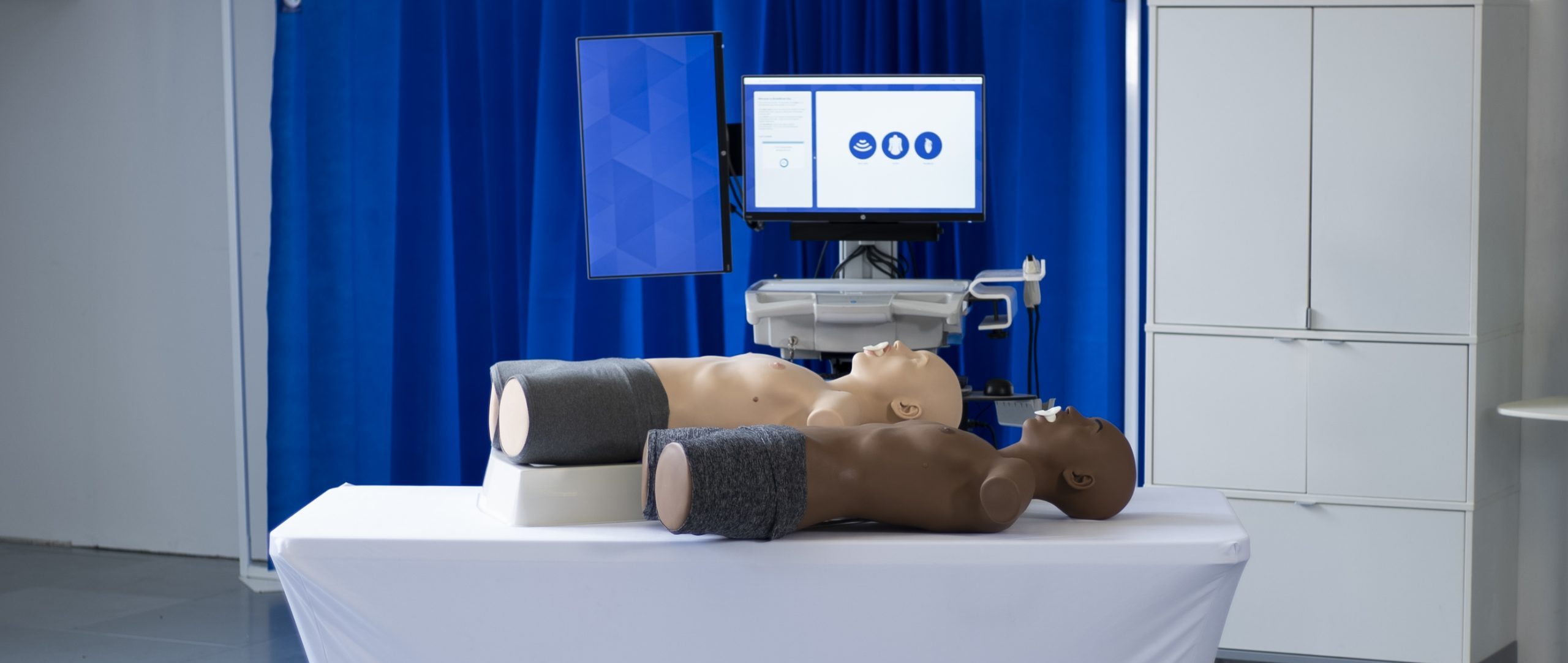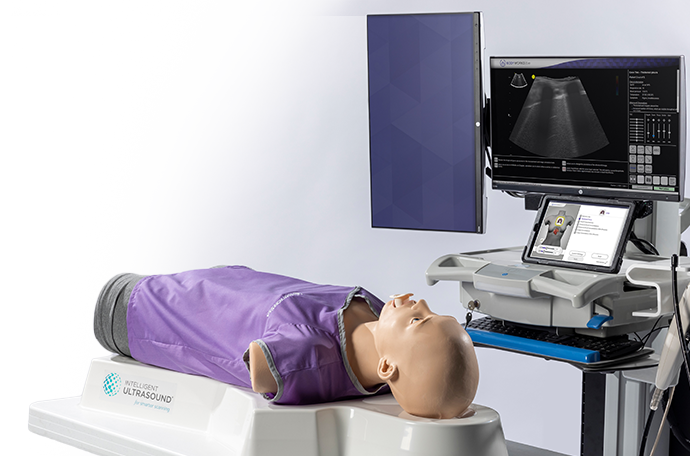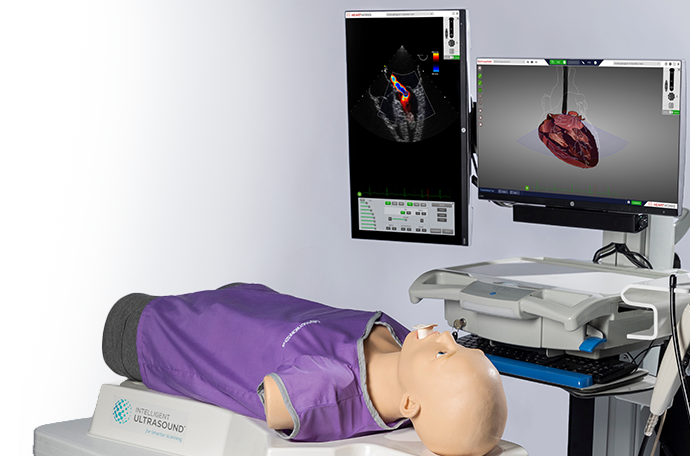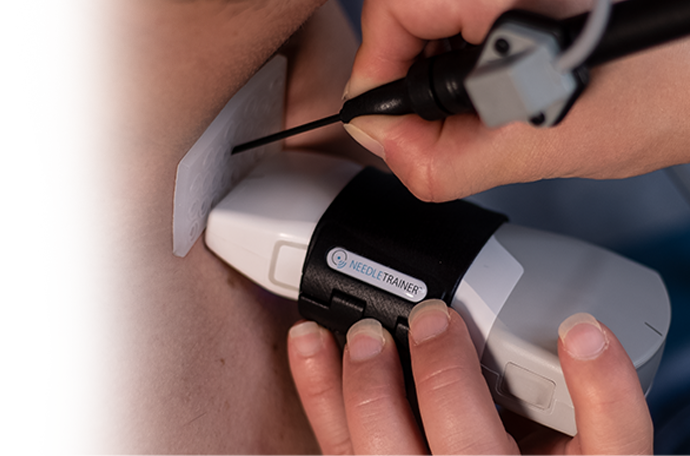
HQ.MED.ED discuss improving rural healthcare education in Minnesota, with Intelligent Ultrasound simulators.
HQ.MED.ED has invested in Intelligent Ultrasound’s BodyWorks Eve, HeartWorks and NeedleTrainer as part of the ‘Minnesota point of care ultrasound project’ to educate thousands of healthcare professionals in rural areas across the state.
HQ.MED.ED (High Quality Medical Education) was founded more than 20 years ago as a group of emergency medicine physicians providing medical training courses. Based out of Hennepin County Medical Center, the busiest trauma center in Minnesota, the organization now offers multiple courses across emergency medicine and is pioneering a new project to teach point-of-care ultrasound (PoCUS) to rural practitioners in underserved areas across Minnesota.
The three-year, $6 million project is made possible by funding from a philanthropic group with an emphasis on improving rural healthcare and availability of services. Thomas Pahl, PA-C, has been working with HQ.MED.ED for more than 15 years. He explained how the project came about:
“I previously worked in an area that didn’t have a lot of resources, so PoCUS was vital to my ability to care for patients. Being involved in healthcare education, you realize just how difficult it is for people in rural areas to become competent with it, and you not only have to be able to acquire the images, but you also have to be able to interpret those images. Just like piano, becoming good at point-of-care ultrasound takes a lot of practice. But if you’re geographically isolated and there’s not a lot of resources available, you often don’t have the experts at hand to provide feedback, and it’s really hard to see people who have pathology.
I reached out to the trust as part of their project to supply equipment to rural hospitals and said ‘hey, the equipment you are providing these hospitals is vital, but probably just as vital is access to high-quality training and education’. We were then granted funding to setup this project and the opportunity to collaborate with and train hundreds of great people throughout the state of Minnesota.” Thomas Pahl, PA-C
The ‘Minnesota point-of-care ultrasound project’ will educate all the critical access, small, or underserved area hospitals and their medical providers in point-of-care ultrasound, using a combination of online distance learning courses, on-site training and regional conferences featuring live scanning on models, and high-quality simulation using Intelligent Ultrasound’s BodyWorks Eve, HeartWorks and NeedleTrainer.
“It’s a multifaceted, multiyear project. We put together a curriculum that involved online content, so people can learn anytime, with the ability to upload images from a handheld ultrasound scanner to get an expert review and feedback. We even have a helpline they can call. We then hold regional conferences throughout the state, with 15 to 20 point-of-care ultrasound experts providing lectures, demonstrations, and a lot of hands-on scanning. In addition, every year one of the specialist instructors will visit the local hospital or healthcare center and provide onsite training with the clinical team there.
There are all kinds of opportunities for students to work on acquiring images, but at the regional conferences, where we bring the simulator, that is the next level. At the end of this project, we have to believe that we’ve trained the learners well enough that they’ll be able to identify pathology and make good clinical decisions. By using high-fidelity simulators, that are really intuitive and easy to use, we can fast track that learning so much. We are getting these students ready for when the training wheels come off, when they’re not with an expert and they need to be able to identify the pathology and manage the patient. With this project, where it’s longitudinal over three years, we have a chance to interact with students multiple times, and by integrating all of these things together, we’ve are able to meet that need and in the long run it’s going to save lives.” Thomas Pahl, PA-C
We have all used different simulators from different manufacturers and we believe this one from Intelligent Ultrasound is the best one that we have used.
Thomas Pahl, PA-C
The initial phase of the project will primarily feature BodyWorks Eve and HeartWorks, focusing on core point-of-care ultrasound skills, emergency medicine protocols and pathology recognition – with NeedleTrainer to feature later in the program alongside ultrasound-guided needling. Amy Osterman, RT(R)(M) VS) RDMS, an expert sonographer who coordinates and teaches at the regional conferences, shared how the simulators were received at the first conference in December.
“In the morning we did a lot of normal live scanning and then in the afternoon moved onto the simulator. It was really well received by the learners and our experts and created such a wonderful learning environment. It’s amazing to be able to run pathologies on the fly. You can start out with just a sliver of free fluid, have them scan some other things and go back to recheck the Morrison’s pouch and increase the fluid and change the heart rate, and really make it into a live scenario they may come across in their clinical practice. There is always more to learn but the learners definitely feel more comfortable with these scenarios coming away from the session.” Amy Osterman, RT(R)(M) VS) RDMS
“The big emphasis is that your ZIP code shouldn’t determine the level or the quality of healthcare that you get. As a rule, we like hands on learning, and scanning real people is hard to substitute. But for something that requires a lot of hands-on training coordination, a simulator is a tremendous tool to get the mechanics and learn the anatomy. In addition, you not only have to teach learners image acquisition, but you also have to help them see pathology, and it’s hard to find a lot of people with the myriad of pathological conditions they need to learn, particularly in these rural areas. In some of these centers a tamponade for instance may only present once every few years. So, by creating this hybrid model where they do live scanning on healthy models and having the simulators, you get the best of both worlds.” Thomas Pahl, PA-C

“It’s very, very dynamic. You can increase the heart rate and add all kinds of pathology, such as a fluid, or a hemothorax, and create real-world type of situations that are really hard to simulate normally. You need to learn to integrate all the things that you’ve learnt and then, importantly, make good medical decisions. And when you’re having to do that all on the fly, real time, with an unstable or critically ill patient, it is cognitively very difficult. So, this is a way to have that opportunity in a low stress environment with an expert, to make those mistakes you inevitably make when learning.” Thomas Pahl, PA-C
HQ.MED.ED had experience with ultrasound simulators before this project but decided to explore all options available in the market to ensure their learners had access to the best equipment available. After careful evaluation, the project invested in Intelligent Ultrasound’s BodyWorks Eve and HeartWorks to provide high-fidelity simulation in point-of-care and cardiac ultrasound.
Thomas explained the reasons for their decision. “We did have a simulator from another company. The problem is not all simulators are created equal, and we’ve learned that somewhat the hard way. We’re always looking for new ways to enhance the learner’s experience so as this project came forward, we wanted to explore what other options we had for simulation. Most of us have had hands-on with different simulators from different companies over time. But until you’re using them more regularly, it’s really hard to know the nuances and what sets them apart.
A simulator is never going to be the exact copy of what something looks like in real life, but we believe this is as close as you can get.
Thomas Pahl, PA-C
But now that we’ve had a chance to use them, we have been ecstatic with BodyWorks Eve and HeartWorks. The ease of use, the high-fidelity images, and the ability to just turn on pathology, it really just sets it apart. You have a tablet to control the pathology, and if you want to add hydronephrosis, you click it. If you want to increase the heart rate, you increase the heart rate. If you want to add B lines or take away lung sliding, it’s so easy. And so you can take a learner through just a simple pathology, or you can go through a whole scenario and make the pathology more complex on the fly.” Thomas Pahl, PA-C
“I work at Hennepin County Medical Centre in the emergency department. I’m a registered sonographer there and I teach the emergency medicine residence physicians. Hennepin’s such a big place, and we train so many people, a lot of people will call us and ask us what our opinion is on a lot of equipment. It’s really great to have a product that we feel so good about that we tell them that we’ve used this, and we love it. In addition, the support has been amazing. In the past, we may have bought good equipment, but without good support it can be really frustrating. But intelligent ultrasound has been outstanding to work with.” Amy Osterman, RT(R)(M) VS) RDMS

“We want to help people get great equipment so they can train great people to do exceptional things. Simulators are expensive, but they’re an important part of the educational process. We want other people to have a chance to use the best equipment possible and use it to enhance their learning so if we identify some product that we believe is more beneficial, we want to support that. We have all used different simulators from different manufacturers and we believe this one from Intelligent Ultrasound is the best one that we have used.
A simulator is never going to be the exact copy of what something looks like in real life, but we believe this is as close as you can get. And the ability to dynamically change the scenario and the pathology in real time; it enhances the learner’s experience and their ability to learn this pathology and helps with their level of comfort in clinical scenarios and gives them the most realistic experience.” Thomas Pahl, PA-C
The project also invested in Intelligent Ultrasound’s NeedleTrainer to provide realistic, safe training in ultrasound-guided needling. Although the project has yet to reach advanced skills such as regional anesthesia and vascular access, the team shared their reasons for the investment and how they expect to implement the equipment.
“We offer a number of courses across a tiered curriculum, and ultrasound-guided procedures such as regional anesthesia will be coming in the later years of the project. For those courses we generally have three cadavers to get the hand-eye coordination. So NeedleTrainer will provide us with that hybrid model. NeedleTrainer gives learners the opportunity to do live scanning on a real person to practice image acquisition, and also work on needle coordination at the same time, which is cognitively very different. NeedleTrainer will offer another opportunity for people to get the dexterity, hands-on, in a low pressure or very safe environment to learn. To get that live image and then have that simulated needle go down through the tissues towards the target structure without harming anyone.” Thomas Pahl, PA-C

The project aims to ensure all healthcare professionals in rural and underserved areas across Minnesota are proficient in point-of-care ultrasound, and confident in identifying relevant pathology, to ultimately improve access to healthcare across the entire state. Thomas explained “The end goal is for the healthcare providers enrolled in this project to be proficient at point-of-care ultrasound, so they are confident in implementing PoCUS into their everyday clinical decision making. Point-of-care ultrasound is one of the few medical advancements that has brought the provider back to the patient’s bedside. CT imaging, lab tests, they are all done elsewhere, PoCUS is one of the few medical advancements that really brings the clinician to the patient. It’s a dynamic process making these critical decisions, especially for the more ill patients. So, our goal is that these people can feel confident in using point-of-care ultrasound, identifying pathology and making clinical decisions at the bedside, and as a result, to improve patient care.”
Amy and Thomas shared that this 3-year project is laying the groundwork to ultimately improve healthcare in rural areas across Minnesota, but there is always the potential to go further and they look forward to seeing what this initiative leads to in the future.
Interactive Point-of-Care Ultrasound (PoCUS) Scenario Training.
Simulation in Cardiac Anatomy, Echocardiography and Lung Ultrasound.
Realistic, Safe & Effective Training in Ultrasound-Guided Needling.


